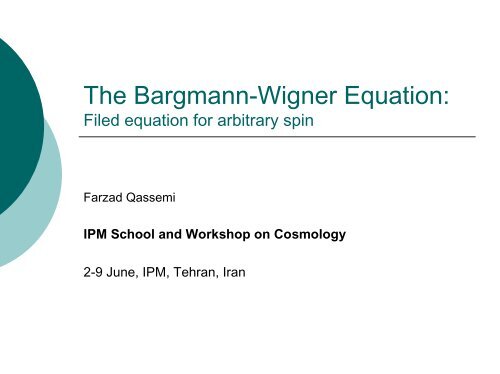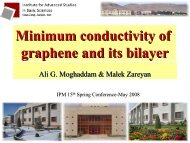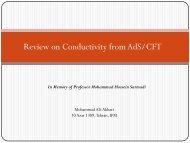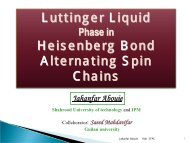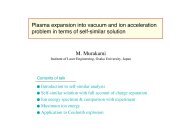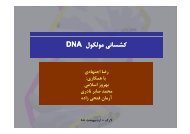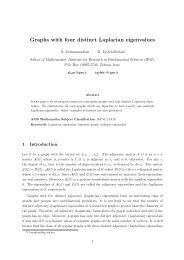Create successful ePaper yourself
Turn your PDF publications into a flip-book with our unique Google optimized e-Paper software.
<strong>The</strong> <strong>Bargmann</strong>-<strong>Wigner</strong> <strong>Equation</strong>:<br />
Filed equation for arbitrary spin<br />
Farzad Qassemi<br />
IPM School and Workshop on Cosmology<br />
2-9 June, IPM, Tehran, Iran
Motivation<br />
◦ De-Broglie fusion theory of light:<br />
1) It was motivated by De Broglie to derive<br />
Maxwell’s equation as emergence field<br />
equation of two spin ½ massless<br />
particles (Neutrino in that time)<br />
2) <strong>Bargmann</strong> and <strong>Wigner</strong> in their seminal<br />
paper in 1948 group theoretically<br />
speaking, generalize this approach to<br />
the field equation for arbitrary spin
Review<br />
◦ Dirac equation:<br />
(γ.<br />
∂ + m)ψ =<br />
0<br />
◦ Set of Gamma matrices<br />
I<br />
, γ , γ , γ γ , σ<br />
5 µ 5 µ µν<br />
Note: they form a complete set.
Charge conjugation operator<br />
*<br />
Cψ =ψ<br />
C<br />
−1<br />
γ<br />
5 5<br />
Cγ =<br />
T<br />
C γ C<br />
−1<br />
= −γ<br />
µ µ
Procedure<br />
1) We symmetries spinor of rank “n” ,<br />
2) It satisfies Dirac equation for each<br />
spinor index:<br />
ψ αβ..<br />
( γ.<br />
∂ + m)<br />
ψ αα α ' β ...<br />
'<br />
=<br />
0
Spin-1 Particle<br />
◦ Group theoretically speaking, the<br />
symmetric state of two spin-½<br />
particles gives spin-1particle. B-W<br />
method helps us to derive the field<br />
equation corresponding to new field<br />
equation. In spin-1 case it means<br />
we can derive Maxwell’s (Proca)<br />
equation from Dirac equation!
Spin-1<br />
ψ<br />
µ<br />
µν<br />
αβ<br />
= A ( γ σ<br />
µ<br />
C)<br />
αβ<br />
+ F (<br />
µνC)<br />
αβ<br />
◦ Now we contract above equation with;<br />
( C<br />
γ ) ,( C γ ) ,( C )<br />
−1 −1<br />
−1<br />
5 βδ 5γ ν βδ<br />
βδ
Spin-3/2 (Rarita-Schwinger eq)<br />
◦ We can continue to make a spin 3/2<br />
particle as follow;<br />
ραβ<br />
µ<br />
ρ<br />
µ<br />
αβ<br />
µν<br />
ψ = A ( γ C)<br />
+ F ( σ C)<br />
ρ<br />
µν<br />
αβ<br />
◦ Follow the same method of contraction.
Modified BW<br />
◦ Q: We examine if fully antisymmetrization<br />
spinor gives us<br />
what we expect.<br />
◦ A: Yes.
Spin-0<br />
◦ Here we try to (re)derive Klein-<br />
Gordon equation from second rank<br />
anti-symmetric spinor.<br />
◦ <strong>The</strong> general method is as before,<br />
except we changed the expansion of<br />
the spinor with respect to antisymmetric<br />
gamma matrices.
Spin-0<br />
ψ = A + )<br />
αβ<br />
ν<br />
( γ<br />
5C)<br />
αβ<br />
+ B ( γ<br />
5γνC)<br />
αβ<br />
F(<br />
C<br />
αβ<br />
◦ Now, we contract above spinor with<br />
symmetric gamma matrices.<br />
( C<br />
−1 −1<br />
µ<br />
)<br />
βδ<br />
,( C σ<br />
µν<br />
γ )<br />
βδ
Summary<br />
◦ Starting from Dirac equation one<br />
can derive higher spin field<br />
◦ By modifying BW we examine<br />
validity of the Anti-Symmetric state
Thank You<br />
Thank You


